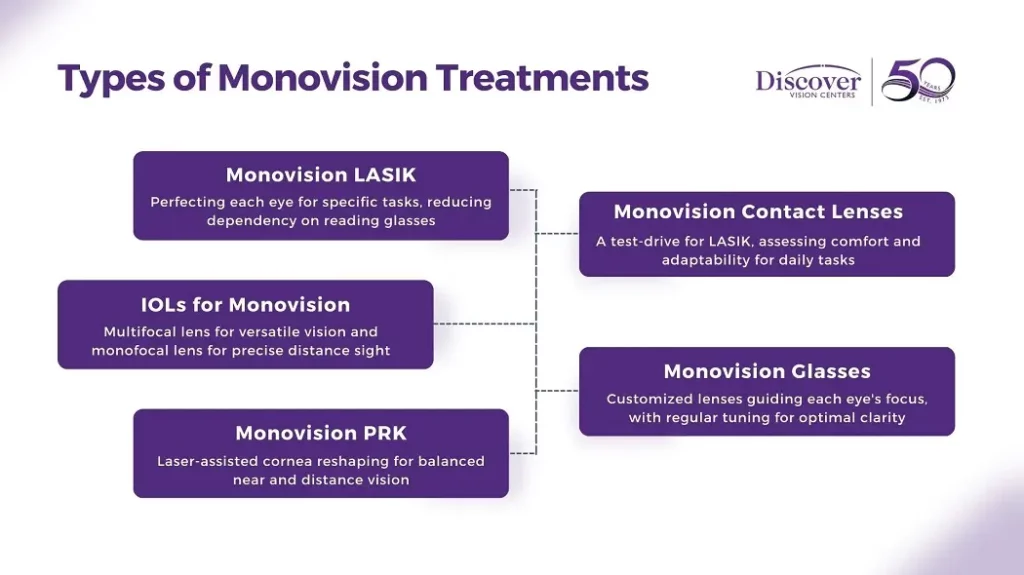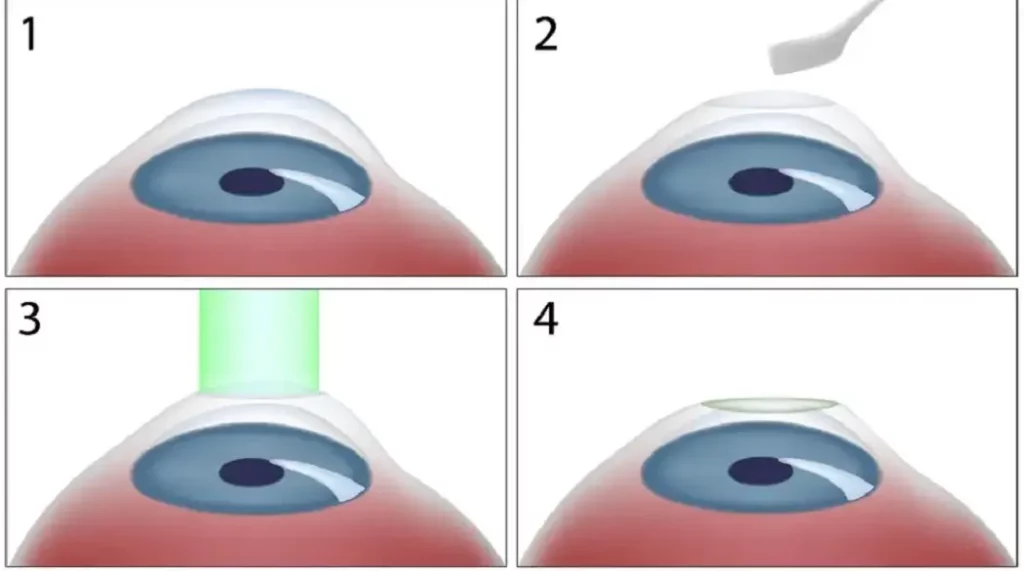
Updated: February 08, 2024

Monovision eye surgery has gained significant popularity due to the growing need and demand for improved vision at multiple distances without relying on glasses or contact lenses. With age-related presbyopia affecting millions of people worldwide, monovision surgery offers a potential solution. This technique involves correcting one eye for distance vision and the other eye for near vision. By creating a balance between the eyes, individuals can enjoy clear vision at different distances, reducing the need for visual aids. The rising demand for monovision eye surgery reflects the desire for greater convenience, freedom, and an improved quality of life for those experiencing presbyopia.
Monovision is an approach used to address presbyopia, an age-related condition that affects near vision. How does monovision work? With monovision, one eye is corrected for distance vision, while the other eye is corrected for near vision. The dominant eye is typically set for distance vision. This technique takes advantage of the brain’s ability to adapt and prioritize visual input from one eye at a time, depending on the viewing distance. The brain seamlessly merges the images from both eyes, allowing individuals to see clearly at different distances. Monovision correction for presbyopia helps reduce reliance on reading glasses or bifocals, providing improved visual flexibility.

There are various types of monovision treatments available for individuals with presbyopia. Treatment options include contact lenses, refractive surgery (such as LASIK, SMILE, or PRK), and intraocular lens (IOL) implants. The specific treatment option depends on factors such as lifestyle, visual needs, and the advice of an eye care professional.
What is monovision eye surgery? Monovision LASIK is a refractive surgical technique used to correct presbyopia, a condition that causes near-vision difficulties. During monovision correction with LASIK, one eye is treated for distance vision, while the other eye is intentionally slightly undercorrected for near vision. This creates a balance between the eyes, which allows individuals to see clearly at both near and far distances without the need for reading glasses. The brain adapts to prioritize the dominant eye for distance vision and the non-dominant eye for near vision. Monovision LASIK provides improved visual flexibility and reduces one’s dependence on reading glasses for daily activities.
Intraocular lenses (IOLs) can be used with monovision correction for cataracts as well for as individuals with presbyopia. Using this approach, during cataract surgery or refractive lens exchange, two different types of IOLs are implanted. One eye receives a multifocal or extended depth of focus (EDOF) IOL, which provides a range of vision from near to far distances. The other eye is implanted with a monofocal IOL that is set for distance vision. Similar to monovision LASIK, the brain adapts to prioritize the dominant eye for distance vision and the non-dominant eye for near vision. This allows individuals to achieve clear vision at different distances and reduces the need for reading glasses. It is important to consult with an eye care professional to determine if cataract surgery correction for monovision is best for your specific needs and visual goals.

Photorefractive Keratectomy (PRK) is a laser eye surgery technique that can be used to treat monovision with laser vision correction. It reshapes the cornea to correct nearsightedness or farsightedness in one eye while leaving the other eye slightly nearsighted or farsighted to enhance reading or distance vision. This is a popular option for those seeking presbyopia correction.
Monovision contact lenses offer a simple solution for presbyopia, allowing one eye to focus on near objects and the other eye to focus on distance, reducing the need for reading glasses. Before committing to monovision LASIK, it’s wise to try monovision contact lenses. This allows you to assess comfort, vision quality, and your personal adaptability to this correction method, ensuring it’s the right choice for you.
If your eye doctor recommends monovision correction glasses, you can expect improved near vision in one eye while maintaining good distance vision in the other. Initially, there may be an adjustment period as your brain adapts to this new way of seeing. It’s essential to understand that while monovision glasses can reduce your reliance on reading glasses, they may not be the ideal solution for everyone. Your eye care provider will guide you through the process to ensure your visual comfort and satisfaction. Regular follow-up appointments will help fine-tune the prescription to suit your unique needs.

Monovision eye surgery offers a world of benefits. It means saying goodbye to reading glasses and enjoying both distance and near vision without relying on corrective lenses. This flexible solution helps manage presbyopia and will make everyday tasks feel easier to achieve. In addition, the long-term results are impressive, with high patient satisfaction rates. So, if you’re looking for a vision correction option that lets you see clearly and comfortably at any distance, monovision surgery might just be the answer you’ve been waiting for.
Monovision, while offering enhanced near and distance vision, does come with a few compromises to consider. These compromises may include reduced depth perception, which can affect activities like sports or driving. Some individuals may experience a slight decrease in contrast sensitivity and visual quality when compared to both eyes being corrected for distance vision. For some, night driving can be affected by seeing glare or halos around lights. However, it’s essential to remember that the degree of compromise for monovision problems varies from person to person. Many monovision users adapt well to these changes and begin to enjoy the convenience of reduced dependence on reading glasses.
Monovision compromises may include:

The cost of Monovision LASIK surgery can vary depending on several factors, including your location, the specific type of procedure performed, and the reputation of the surgeon or eye center. It’s essential to keep in mind that these costs often cover the surgical procedure, preoperative and postoperative care, and follow-up appointments for a specified amount of time. Additionally, some insurance plans may offer partial coverage for monovision surgery, so it’s advisable to check with your insurance company or provider.
To get a precise estimate and discuss your suitability for monovision surgery, we recommend scheduling a consultation at Discover Vision Centers. Our experienced team of eye care professionals will assess your unique needs and provide you with a personalized treatment plan. The treatment plan will include a detailed breakdown of the surgery price as well as information on financing options for LASIK eye surgery costs through CareCredit, subject to credit approval. Take the first step towards visual freedom; contact us today and book your consultation. Your clear, glasses-free future awaits!

Adapting to monovision after surgery can take some time, but, with patience and practice, it can become a seamless part of your daily life.
Tips for adapting to monovision after surgery:
By following these tips and staying committed to the process, you’ll likely find that monovision becomes a natural and convenient way to enjoy clear vision at both near and far distances.

Monovision is a suitable choice for those looking to reduce their dependence on reading glasses while maintaining good distance vision. Potential candidates for monovision correction are typically individuals aged forty and older who are experiencing presbyopia, a common age-related vision issue. Ideal candidates should have healthy eyes with stable vision and realistic expectations about the potential compromises of in-depth perception and contrast sensitivity.
Before considering monovision, it’s essential to undergo a comprehensive examination. At Discover Vision, we encourage you to schedule a free LASIK consultation to discuss your specific needs and goals with an experienced eye care professional. During your consultation, we will perform a number of tests to determine if monovision or another option is best for you. An in-depth consultation will help determine if monovision is the right solution to enhance your overall quality of life and vision.

Monovision surgery is a vision correction option that offers enhanced near and distance vision and reduced reliance on reading glasses. Typically recommended for those experiencing presbyopia, it involves adjusting one eye for close-up tasks while maintaining distance vision in the other. The cost of monovision correction surgery can vary based on the amount of correction needed and whether insurance or other discounts are available. Follow-up appointments will help ensure success, but it’s important to remember that adjusting to monovision may take some time.
To explore whether monovision surgery is right for you, schedule a free LASIK consultation at Discover Vision Centers today. Your path to clearer vision and a reduced dependence on reading glasses awaits! Call 816-478-1230 or request an appointment online.
Adjusting to monovision varies from person to person, but it typically takes a few weeks to a few months to acclimate to the new vision balance between eyes. Regular activities like reading or using digital devices can speed up the adaptation process. Patience and consistent practice are key to achieving comfortable and effective monovision.
Monovision differs from other vision correction surgeries by intentionally setting one eye for near vision and the other for distance, addressing presbyopia. In contrast, traditional vision correction methods like LASIK or SMILE aim to correct both eyes for distance vision. As individuals age or reach the age of forty, reading glasses may be required for up-close tasks, such as reading. The goal of monovision is to provide the convenience of clear vision at varying distances without the constant need for reading glasses.